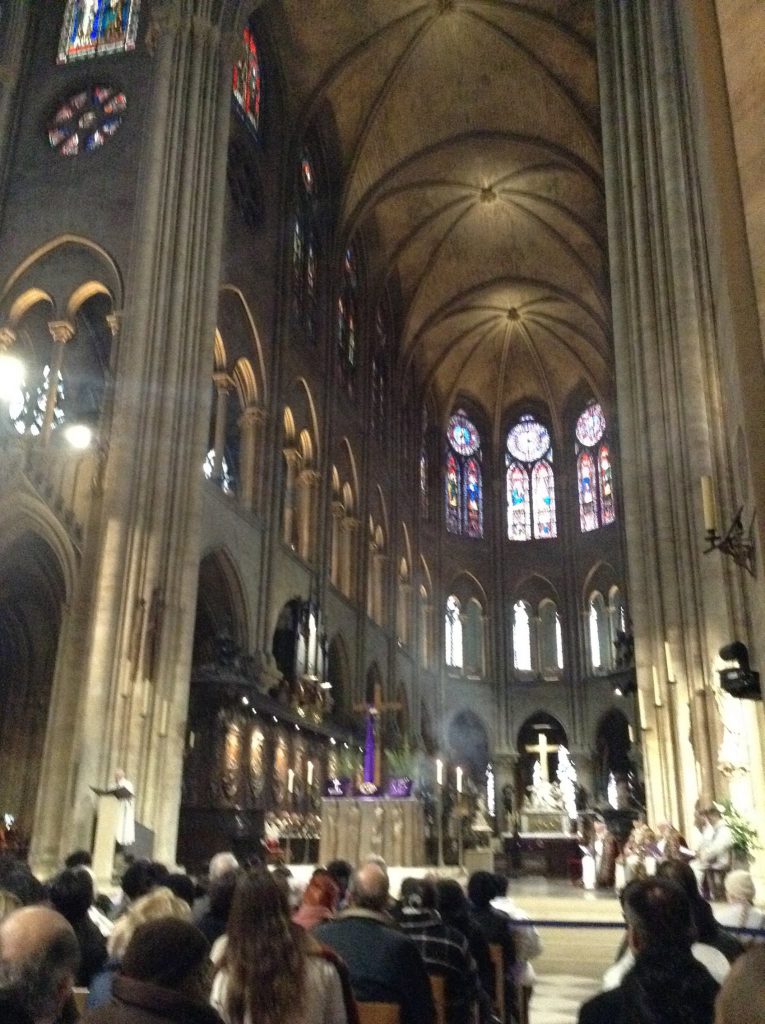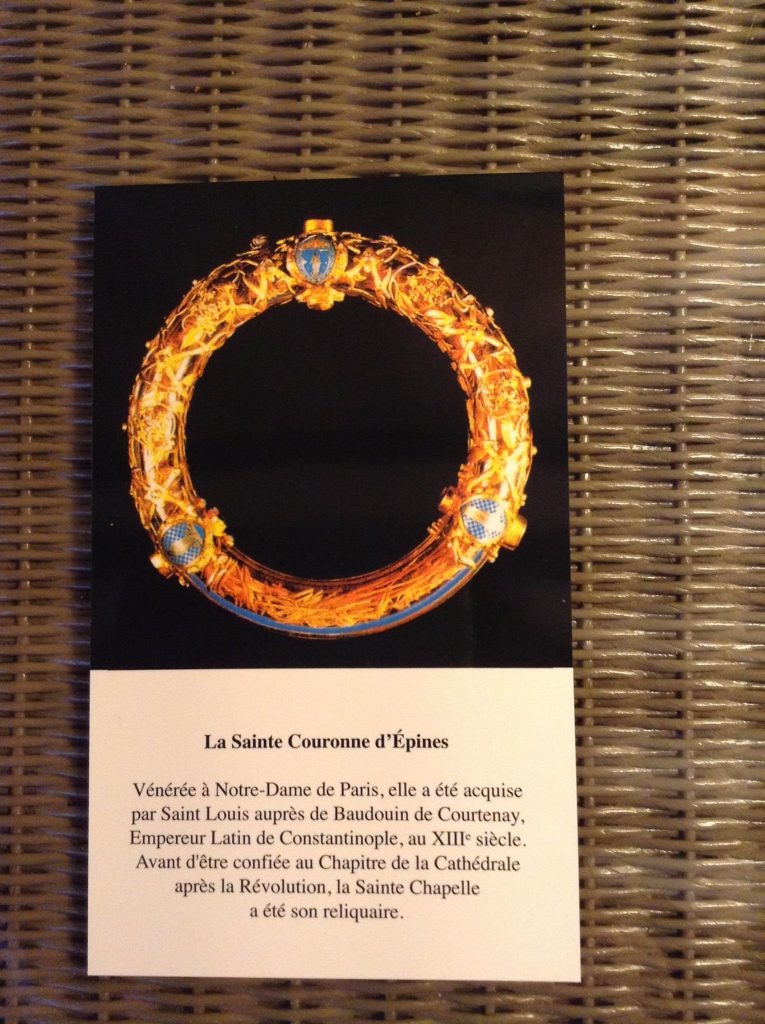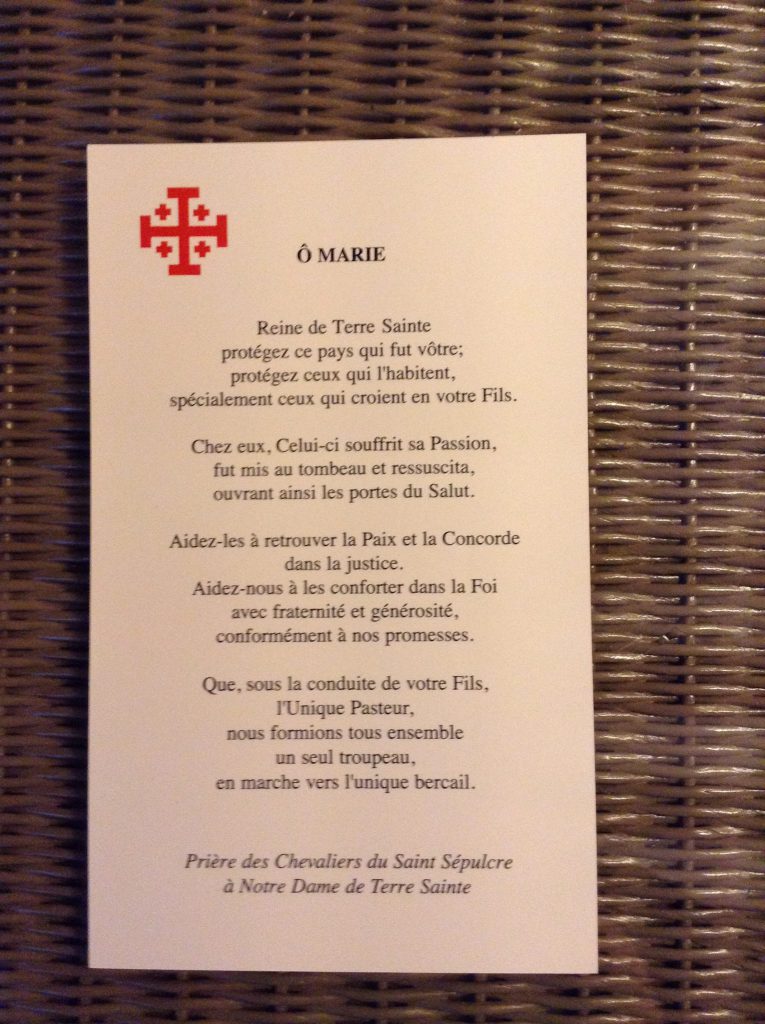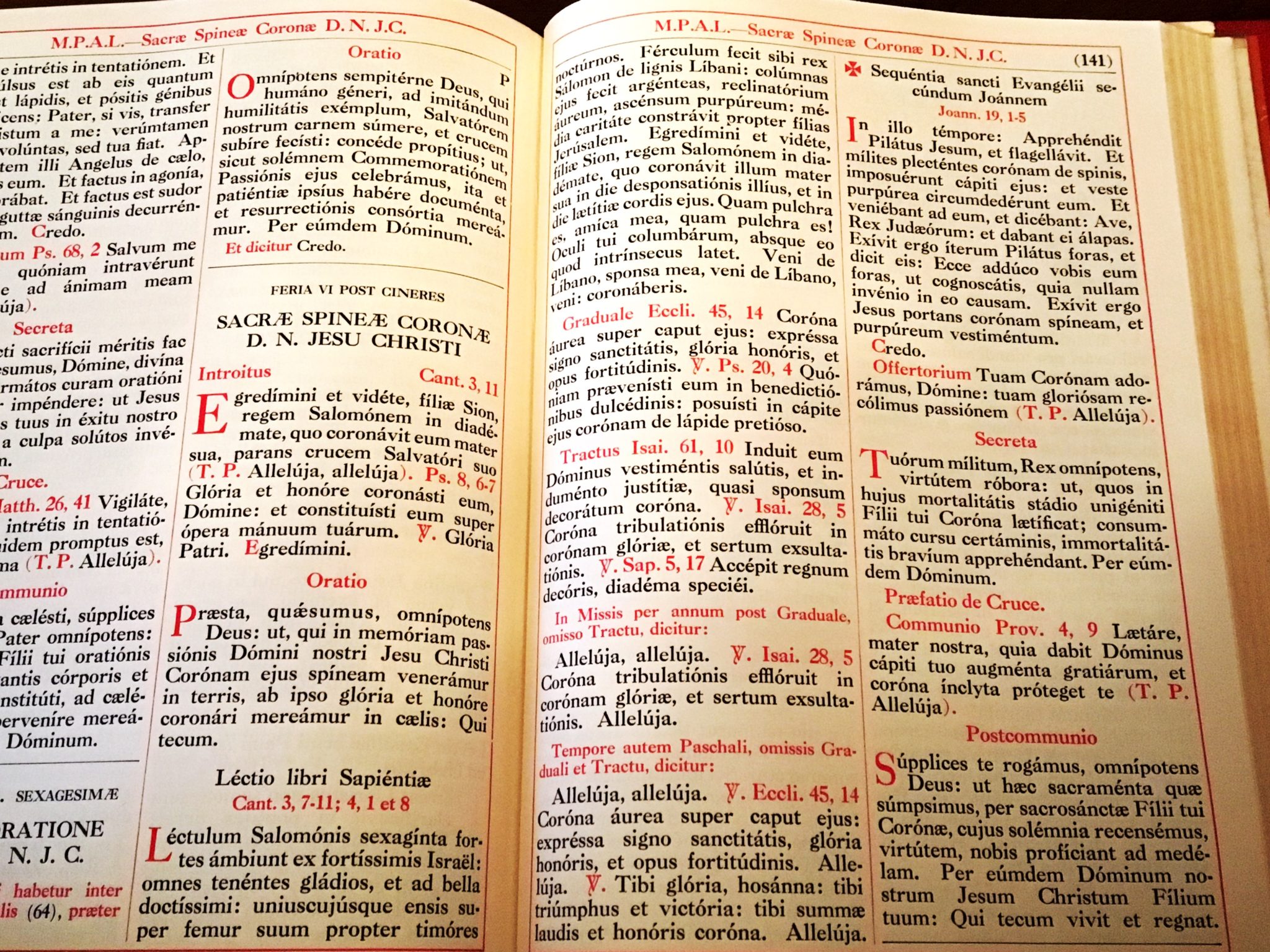UPDATE: A reader has sent photos from the Cathedral of Notre Dame in Paris where she saw the relic exposed!
She wrote:
I was impressed by the huge crowd and most went up to venerate the Crown. The service was dignified, beautiful and moving. No antics. No craziness. Moral of the story? When people come to church they want the Faith, the authentic Faith. They don’t want to be entertained. They go elsewhere for that.



_____
A reader sent…
Feria Sexta post Cineres [Friday after Ash Wednesday] is the feast of the “Crown of Thorns”- one of the old Friday devotional feasts (in aliquibus locis) regrettably lost before 62… Might be worthy of a blog post or incorporation into your LentCaZt. [Already made before I opened the email.]
To this day at Notre Dame (where a significant portion of it is preserved), they have a special Crown of Thorns Mass on Fridays of Lent, and the relic is exposed… Not sure if the propers were changed under Novus Ordo, but am attaching the traditional propers for your convenience
The history of the Crown of Thorns itself is intriguing… transferred from Jerusalem to Constantinople, it was pledged to Venice for a heavy loan before being redeemed by the saintly Louis IX and taken to Paris, where it survived the Revolution and remains today.

Also, while the Crown of Thorns feast would not be celebrated under the 1962 rubrics, I believe it would be licit as a Votive Mass on some ferial Friday per annum. Perhaps a priest assigned to a liberal tyrant pastor could use it on or near the anniversary of his assignment. Of maybe some priests could say it with a special intention for the bishop… or another prelate.


































The Good Old Dominican Rite still has it on April 24.
Another reason for the Church to allow the pre-Pius XII books.
Fascinating. Not in my 1915 Breviary, nor in an altar missals of 1840, but I have it in an altar missal of 1957, pro aliqu. loc.. Friday after Dom I Quad is the Holy Holy Lance and Nails of OLJC; Friday Post Dom II the Holy Shroud; that Post Dom III The Five Holy Wounds; Post Dom IV the Precious Blood OLJC.
Interesting that in Paris the Crown Mass is weekly, but logical. The Holy Relics are exposed on First Fridays and Good Friday.
The Office and Mass chants can be found in the 1912 Antiphonale Romanian and the 1908 Graduale Romanian, respectively.
The Passionists still have this as a Votive Office.
Text of Archbishop Lefebvre: http://www.sspxasia.com/Documents/Archbishop-Lefebvre/Apologia/Vol_three/Chapter_62.htm
Pax tecum Father Z. We pray for you.
I’VE SEEN IT! it was about 15 years ago, and my family (we had six kids with us) was visiting Paris. It would have been around Epiphany. Norte Dame was on our list of places see, of course. We got there, and it turned out that they had the Crown, and were going to expose it! There’s a brotherhood of men who are dedicated to this. When they saw all of us, they invited our family to process down the aisle with them. I was thrilled!
It seems that you are (begging your pardon) not right about using it as a votive Mass on some 4th-class Friday (or for that matter other day of the week).
The rubrics as presented on the Divinum-Officium sites say:
307. A votive Mass may be:
a) of the mysteries of the Lord;
[…]
308. The following may be celebrated as votive Masses of the mysteries of the Lord:
a) in the universal Church:
1) of the Most Holy Trinity;
2) of the Most Holy Name of Jesus;
3) of the Most Sacred Heart of Jesus;
4) of the Most Precious Blood of our Lord Jesus Christ;
5) of Christ the King;
6) of the most holy sacrament of the Eucharist;
7) of our Lord Jesus Christ, eternal High Priest;
8) of the holy cross;
9) of the Passion of our Lord; [Close enough.]
10) of the Holy Family, Jesus, Mary and Joseph;
11) of the Holy Spirit;
b) in individual churches, besides the Masses mentioned above, all Masses of feasts of the Lord which are inscribed in the particular calendars, and other votive Masses specially granted.
Masses which refer to mysteries of the life of our Lord, however, cannot be celebrated as votive.
As this list appears quite exhaustive, there does not seem any place for a Votive Mass of the Crown of Thorns of Our Lord Jesus Christ, unless permitted by special indult.
Which is a pity, or would be were it not for the fact that so many days are occupied by third-class feasts that we hardly get to hear the votive Masses that are possible, in any case.
*Romanum
Blasted autocorrect!
Thank you, Father (and commenters)!
Last year, K.V. Turley had a post about a reprint of a book about Relics of the Passion:
http://catholicexchange.com/where-are-the-relics-of-the-passion-and-what-do-they-tell-us
a book published in 1910 by the uncle of a future Inkling, which is also available scanned in the Internet Archive:
https://archive.org/details/relicsofthepassi00walluoft
Not so very many years ago, Schola Hungarica recorded the Propers of a Mass for the Holy Lance and the Nails for Naxos on a CD entitled Das Gansebuch [with a-umlaut] (The Goose Book): Medieval German Chant.
Venerator Sri Lot, I see that CD at Spotify. According to the information presented there, it’s the introit, Alleluia, sequence, offertory, and communion all in twelve minutes (won’t have a chance to listen until this evening, after Stations and Benediction): is there a sequence/prose in the missal?
marcpuckett,
If I recall correctly, this is from a manuscript from the St. Lorenz Church in Nuremberg, and the CD booklet had something about being able to look up the texts via the Naxos website – which I never managed to do.
marcpuckett,
It’s a long time since I visited the Naxos website, but trying just now I quickly found this:
http://www.naxos.com/sungtext/PDF/557412_sung_text.pdf#
and this:
http://www.naxos.com/mainsite/blurbs_reviews.asp?item_code=8.557412&catNum=557412&filetype=About%20this%20Recording&language=English#
Reverend Father,
well, “close enough”, but the Votive Mass “of the Passion of the Lord” is the one specifically called that way, because there is one, and because the Most Precious Blood of our Lord Jesus Christ and the Holy Cross are after all named specifically…
[Haarspalter?]
@Imrahil:
Consulting my 1948 Missale Romanum, which contains said Mass of the Crown of Thorns, in the Propers are listed an Alleluia verse to replace the Tract for Votive Masses per annum, and also an Alleluia to replace the Gradual and Tract for Votive Masses tempore Paschali. So evidently it can be used as a Votive Mass on appropriate days throughout the year.
The rubric restricting Votive Masses of Our Lord refer only to mysteries of His earthly life that occur at a clearly specified time in the temporal liturgical cycle — i.e. Nativity, Epiphany, Easter, Ascension, Transfiguration. Masses of Our Lord which are not strictly tied to the annual liturgical cycle can indeed be used as Votive Masses — e.g. Precious Blood, Most Blessed Sacrament, Holy Cross, Passion, Crown of Thorns.
Dear mschu528,
hm, good point. I mean especially the Alleluia argument.
Reverend Father,
yes, sir!
In the new edition of the Roman Missal, published in Swedish 2013, we were given the privilege to restore the Crown of Thorns as a commemoration on September 2nd. This was due to the devotion to the Crown of Thorns that had it’s own office composed by Bl Brynolf of Skara. He had received a thorn from the Crown of Thorns through the King of Norway in 1304. This relic was “lost” during the Reformation and never recaptured. The office is very beautiful and has been translated from Latin. Annually the Catholic parish nearest to Skara Cathedral (once the first Catholic See in the Country, today Protestant), solemnly celebrates the occasion in the old cathedral itself by kind permission of the protestant parish.
Worth (re)reading in the context from the old Catholic Encyclopedia (as transcribed at New Advent) are Frederick Holweck’s “Feast of the Crown of Thorns” and “Commemoration of the Passion of Christ” and Francis Mershman’s “Passion Offices” articles. For the Feast of the Crown of Thorns, Fr. Holweck noted, “The ‘Analecta hymnica’ of Dreves and Blume contains a large number of rhythmical offices, hymns, and sequences for this feast.” (A bit of a problem here is that, as its editor, Clemens Blume, says in his article, “Hymnody and Hymnology” (1910), “The ‘Analecta Hymnica’ in the meantime has reached the fifty-second volume and will be completed in six more volumes and several indexes.” Thus, while the Internet Archive looks like it may well have scans of all the volumes, how does one know which is the one with these particular rhythmical offices, hymns, and sequences?)
There is a sequence apparently incorrectly attributed to Adam of St. Victor, ‘De Corona Spinea’, in The Liturgical Poetry of Adam of St. Victor : from the text of Gautier, with Translations into English in the Original Metres by Digby S. Wrangham, vol. III, pp. 230-35, variously scanned in the Internet Archive, such as:
https://archive.org/details/liturgicalpoetr03adam
There is also a discussion of a hymn on the ‘Thorn Crown’, with quotations and their translations in a review article in Fraser’s Magazine, May 1849, pp. 529-30, as scanned in the Internet Archive:
https://archive.org/stream/frasersmagazine07unkngoog#page/n559/mode/2up
Thanks, VSL (apologies for getting your ‘name’ wrong yesterday), and each of you. The Naxos pages’ information is fascinating.
marcpuckett,
My pleasure! I’m glad to have finally caught up with text and translation, too, for so interesting a recording. (I hadn’t noticed the misspelling – it’s the sort of typo I’m always making, myself.)
One of the finest early Tudor Masses, John Taverner’s Missa Corona Spinea, was probably written for this feast.